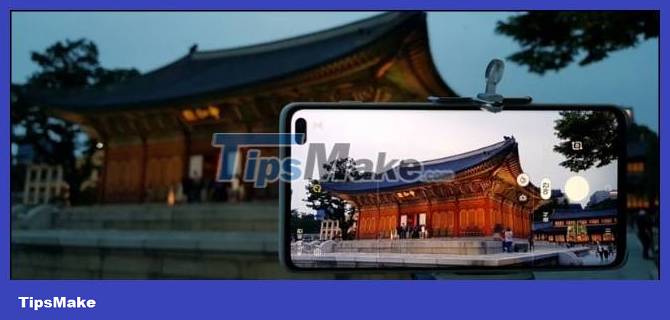How does 'Night Mode' on smartphones work?
The ability to take photos at night, or more accurately, take photos in low light conditions is a fiercely competitive 'battlefield' for all smartphone manufacturers today, especially in the high-end segment. So how does this feature actually work? We will find out together soon.
The quality of low-light photos is increasingly improving on smartphones
Over the past few years, hardware quality and algorithm-based image processing techniques have truly changed the tech world's perception of smartphone photography capabilities. In particular, taking photos in low light conditions - one of the biggest challenges in the field of photography - has become 'exponentially' better each year.
Just a few years ago, phones still had trouble taking even passable photos in the dark, unless the flash was used. But now, they can capture photos with breathtaking detail in the dark - something that for DSLR or professional mirrorless cameras is also a big challenge.
Leading this trend are famous names such as Google, Huawei, Apple, Samsung. With the factor receiving the strongest investment focus being in-depth image processing algorithms, most of which are based on AI. Along with that, sensors are getting better and better quality.

Light and Photography
Before we dive into how night mode works, here are some basic photography terms involved:
- Exposure: The amount of light reaching the camera sensor. It determines the light and dark levels of the photo.
- Shutter speed: The amount of time the camera sensor is exposed to light. Longer shutter speeds allow for longer exposure to light, but can cause blurred images.
- Dynamic range: The range of the darkest (shadows) and lightest (highlights) tones in an image.
- High dynamic range (HDR): An image processing technique in which the camera takes multiple photos at different exposure levels (by varying the shutter speed). It then combines the images to emphasize shadows and highlights.
The result of an HDR photo largely depends on the processing software. Manufacturers may prioritize certain details, but this is not required.
Night shooting mode
Depending on the device/manufacturer, night mode may be automatically activated by the low light detection sensor, or users will have to manually activate it in the Camera app. Either way, taking photos in night mode, at first, seems quite similar to regular photography. But the first difference that you can easily notice is that the time taken to take photos in night mode will be significantly longer. That longer shutter speed is important in processing the photo.
Night mode uses a variation of the HDR technique. It directs the camera to take a series of different photos of the same subject at different exposure levels, by taking them at different shutter speeds. Then, image processing software (algorithm) will align and combine these photos to increase the detail of the photo.
This process allows the highlights of the image to be visible while maintaining the darkness of the shadows. Additionally, it will also highlight details in the shadows that you wouldn't otherwise be able to see in a regular photo.

Some phone models will automatically set the amount of time it takes to take a photo depending on how dark the environment is. Other devices allow you to customize them yourself. This depends on each manufacturer.
The entire process will only take a few seconds. By the time you view the photo, all the work including taking multiple photos, combining them, and optimizing the images will be done and completed in a snap.
Night Mode variations
Nearly all top devices from Apple, Google, Samsung, Huawei and LG support night mode.
The cameras on these devices use proprietary algorithms to determine the optimal appearance of a photo, then synthesize the final image you see. The different combining processes (also known as 'bracketing') that each manufacturer uses is the reason there are large differences in night mode between brands. Although the ultimate goal is the same.
Some photos will feel more natural, while others will over-emphasize highlights to make the entire image look brighter. This largely depends on the specific purpose each manufacturer wants to emphasize.
Furthermore, the actual sensor is also important. Some manufacturers use a combination of high-resolution sensors with a technique called Pixel Binning to get brighter photos in low light conditions. This process involves reducing large pixel sizes to create brighter, more detailed photos.

How to take photos in Night Mode
Regardless of which smartphone model you are using, if it supports night mode, here are some things to keep in mind if you want to get beautiful photos.
An essential part of this process is aligning all the different photos you take. If a long exposure photo taken in night mode is too blurry, you won't get an optimal photo.
This is why most manufacturers recommend that you try to keep the device as still as possible when taking photos in Night Mode. It is also why in most promotional images of this feature , you will only see static subjects. If possible, use a tripod when taking photos in night mode.
Also, try shooting in environments with at least a few dim light sources. Not only does this help improve the quality of the photo, but it can also make it look more impressive after post-processing.
You should read it
- Reddit has Night Mode on the desktop
- How to turn on the dark background interface on iPhone applications
- Twitter's Night Mode night mode launches desktop users
- How to enable Night Mode on Samsung Galaxy S8
- Instructions on how to enable Night Mode on Android Nougat
- How to Enable Night Shift Mode on iPhone
- How to use Night Light mode in Windows 10?
- What is the regime of night sleep on air conditioner?
- How to turn on Night Shift night mode on iOS 11 for iPhone
- 5 web browsers support Dark Mode / Night Mode for Android phones
- How to enable dark mode (Night Mode) on Xbox
- Much more great option to replace Windows 10's Night Light feature
May be interested

How many megapixels does your smartphone need?

Install a webcam for your computer and the simplest way to use it

Difference between SLR and DSLR

Logitech C930e webcam review, the hottest webcam of 2023

The simplest way to check laptop cameras easily at home

2 ways to record macbook screen without software





 Reddit has Night Mode on the desktop
Reddit has Night Mode on the desktop How to use Night Light mode in Windows 10?
How to use Night Light mode in Windows 10? How to turn on the dark background interface on iPhone applications
How to turn on the dark background interface on iPhone applications Twitter's Night Mode night mode launches desktop users
Twitter's Night Mode night mode launches desktop users How to enable Night Mode on Samsung Galaxy S8
How to enable Night Mode on Samsung Galaxy S8 19 tips to help you achieve high efficiency when staying up at night
19 tips to help you achieve high efficiency when staying up at night